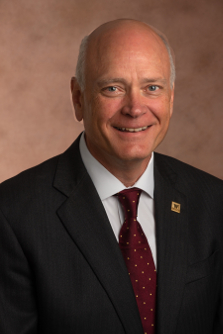
As he leads and guides the medical school’s continuing growth and evolution, Dr. Hal B. Jenson has in his sights the aspiration that WMed build on the history of faculty and resident research in orthopaedics and surgery to leverage local resources and opportunities to become a nationally recognized leader in integrating medical engineering into medical education.
The addition of two new faculty members, the recent launch of a new Division of Medical Engineering in the Department of Orthopaedics, and the growth of the Program in Medical Engineering, he says, will soon help make all of that a reality.
“This is an important step for us – developing interdisciplinary education in the area of medical engineering and developing a program that is very much focused on the clinical aspects of medical engineering,” Dr. Jenson said. “We recognize the importance of medical engineering in medicine as being much more than devices, it’s about improving systems and processes and, in turn, helping the patients we serve.”
The work to build the Program in Medical Engineering and the Division of Medical Engineering at the medical school is being undertaken as part of a larger collaborative effort in medical engineering with Western Michigan University and its College of Engineering and Applied Sciences and its College of Arts and Sciences.
The Program in Medical Engineering at WMed is led by Tycho K. Fredericks, PhD, who also serves as a professor of Industrial and Entrepreneurial Engineering and Engineering Management at WMU. In September, WMed launched a new Master of Science degree in Medical Engineering, an effort that is being spearheaded by Dr. Fredericks and several faculty, including Drs. Keith Kenter and Robert Sawyer, chairs of the medical school’s departments of Orthopaedic Surgery and Surgery, respectively. Many other faculty from WMU and WMed are also participating in the program.
The interdisciplinary, graduate-level program is for engineers and quantitative scientists with an end goal in mind – creating new medical devices and improving systems and processes to improve healthcare. The program welcomed its first student in September.
As part of the program’s expansion and growth, Yong Li, MD, PhD, a renowned educator and researcher, came to WMed in October and will lead the new Division of Medical Engineering. In December, he will be joined by Adil Akkouch, PhD, MSc. Dr. Li’s new role at the medical school follows a seven-year stint at the University of Texas Health Science Center in Houston where he served as an associate professor and laboratory director of the Center of Stem Cell and Regenerative Medicine at the Brown Foundation Institute of Molecular Medicine for the Prevention of Human Diseases, among other leadership roles.
The addition of Drs. Li and Akkouch, and the growth of the Program in Medical Engineering, is being made possible through funding from the Martha G. Parfet Discovery Fund, a fund that was established at the medical school in early 2018 thanks to a $2 million bequest from the estate of Martha Parfet.
“Eventually, the Program in Medical Engineering will grow into the Department of Medical Engineering. That will happen with the success of Drs. Li and Akkouch as they build their independent research programs at WMed with the collaboration of Drs. Fredericks, Kenter, Sawyer, and others” Dr. Jenson said. Drs. Li and Akkouch are also expected to collaborate with an undergradate program in medical engineering that is being developed at WMU.
For Dr. Fredericks, the launch of the new master’s curriculum in September was the culmination of a seven-year process to implement a program that will immerse students into the world of healthcare with a focus on the interface between medicine and engineering.
The program and its growth are being accomplished through ongoing collaboration between WMed and WMU. Students in the program complete five courses physically based at the medical school and three courses physically based at WMU. In the first year, students get the chance to choose a specialty track that fits best with their career goals. That list includes biomechanics and biomaterials, biological signal processing, sensors, and instrumentation, or healthcare systems engineering. As part of their education, students interact with diverse groups of professionals, from engineers and clinicians to surgeons and residents, as well as nurses, medical technologists, and business and regulatory experts.
A key component of the new master’s program is the first 15 weeks of instruction, which immerses students in healthcare where they get an up-close look at the inner workings of clinical settings in Southwest Michigan, gain a deeper understanding of the discipline of medicine, and begin assessing and identifying where they can use their skills to improve processes and instruments.
Dr. Jenson said the new program and the collaboration between the medical school and WMU is an important step in continuing the legacy of success around biomedical engineering in the Kalamazoo community.
“We want to build on that legacy and also be a part of helping build up that expertise in the community,” Dr. Jenson said. “Having that expertise here will contribute to the continued role and national visibility of Kalamazoo in medical engineering.”
Dr. Jenson said he also is confident that the growth of the Program in Medical Engineering and the arrivals of Drs. Li and Akkouch will benefit WMed resident physicians and students by opening the door to additional research opportunities in areas that are clinically important and of interest to our learners.
“Overall, our commitment to the growth of the Program in Medical Engineering will help our faculty and learners understand more about patient flow, resource management, and designing and implementing systems and processes effectively and efficiently,” Dr. Jenson said.

